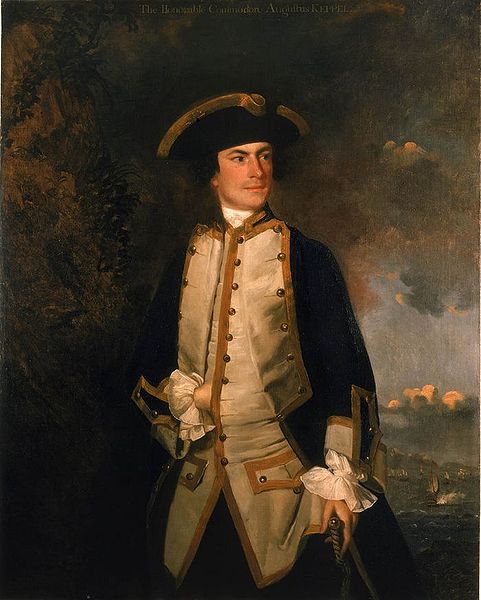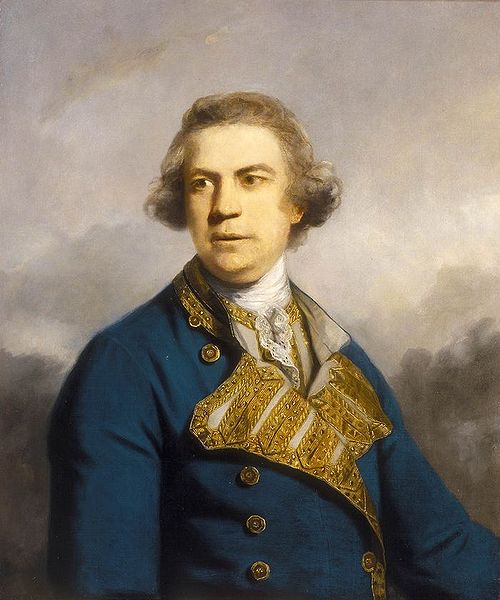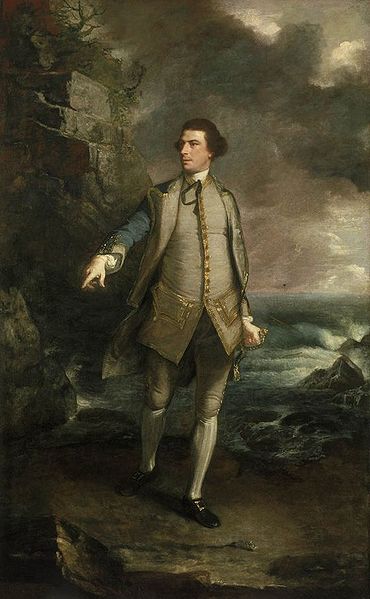<Back to Index>
- Mathematician Andrey Nikolaevich Kolmogorov, 1903
- Bluesman Albert King, 1923
- First Lord of the Admiralty Augustus Keppel, 1725
PAGE SPONSOR



Admiral Augustus Keppel, 1st Viscount Keppel PC (25 April 1725 – 2 October 1786) was an officer of the British Royal Navy during the Seven Years' War and the War of American Independence. During the final years of the latter conflict he served as First Lord of the Admiralty.
A member of a leading Whig aristocratic family (which had come to England with William of Orange in 1688), Augustus Keppel was the second son of Willem Anne van Keppel, 2nd Earl of Albemarle and Anne van Keppel, a daughter of the 1st Duke of Richmond (himself an illegitimate son of King Charles II). Augustus Keppel went to sea at the age of ten, and had already five years of service to his credit when he was appointed to the Centurion and sent with Lord Anson round the world in 1740. He had a narrow escape from being killed at the capture of Paita (13 November 1741), and was named acting lieutenant in 1742. Also on this voyage, he made friends with John Campbell, and lost many of his teeth to the scurvy prevalent on the voyage. After their return from the circumnavigation, in 1744, he was promoted to be Commander and Post Captain. He was actively employed throughout the rest of the War of the Austrian Succession, until peace was signed in 1748. In 1747 he ran his ship the Maidstone ashore near Belleisle while chasing a French vessel, but was honourably acquitted by a court martial, and reappointed to another command.
Early in 1749, he was introduced by Lord Edgecombe to Sir Joshua Reynolds. When, on 11 May 1749, Commodore Keppel sailed from Plymouth to the Mediterranean (to command his old ship HMS Centurion and to persuade the Dey of Algiers to restrain the piratical operations of his subjects) Reynolds travelled with him as far as Minorca and there painted the first of his 6 portraits of Keppel, along with others of officers of the British garrison there. When Keppel arrived to negotiate, the Dey is said to have complained that the King of England had sent a beardless boy to treat with him, and to have been told that if the beard was the necessary qualification for an ambassador it would have been easy to send a Billy goat. After trying the effect of bullying without success, the Dey made a treaty, and Keppel returned in 1751.
During the Seven
Years'
War he saw
constant service. He was in North America in 1755, on the coast of
France in 1756, was detached on an expedition
to
conquer Gorée a
French
island off the west coast of Africa in 1758, and his ship the Torbay was the
first to get into action in the Battle
of
Quiberon Bay in
1759. In 1757
he had formed part of the court martial which had condemned Admiral Byng,
but
was active among those who endeavoured to secure a pardon for him;
but neither he nor those who had acted with him could produce any
serious reason why the sentence should not be carried out.
In March 1761, Keppel transferred to HMS Valiant and was put in command of a squadron to reduce Belle Isle, which was successfully completed in June. When Spain joined France in 1762 he was sent as second in command with Sir George Pocock in the British expedition against Cuba which took Havana. His health suffered from the fever which carried off an immense proportion of the soldiers and sailors. The £25,000 of prize money which he received freed him from the unpleasant position of 'younger son of a family ruined by the extravagance of his father'.
He
became
Rear Admiral in October 1762, was one of the Admiralty Board from July 1765 to
November 1766, and was promoted Vice Admiral on 24 October 1770. When
the Falkland
Island dispute
occurred in 1770 he was to have commanded the fleet to be sent against
Spain, but a settlement was reached, and he had no occasion to hoist
his flag. The most
important and the most debated period of his life belongs to the
opening years of the American
War
of Independence. Keppel was by family connection and personal
preference a strong supporter of the Whig connection, led by the Marquess
of
Rockingham and
the Duke
of
Richmond. He shared in all the passions of his party, then
excluded from power by the resolute will of George
III. As a
member of Parliament, in which he had a seat for Windsor from 1761 until 1780, and
then for Surrey he was a steady partisan,
and was in constant hostility with the King's
Friends. In common with them he was prepared to believe that the
king's ministers, and in particular Lord
Sandwich, then First
Lord
of the Admiralty, were capable of any villainy. When therefore
he was appointed to command the Western Squadron, the main fleet
prepared against France in 1778, he went to sea predisposed to think that the First Lord would be glad for him to be defeated. It was a
further misfortune that when Keppel hoisted his flag one of his
subordinate admirals should have been Sir Hugh
Palliser (1723 – 1796), who was a member of the Admiralty Board, a
member of parliament, and in Keppel's opinion, which was generally
shared, jointly responsible with his colleagues for the bad state of the Royal
Navy. When, therefore, the battle which Keppel fought with the
French on 27 July 1778 (the First
Battle
of Ushant) ended in a highly unsatisfactory manner, owing
mainly to his own unintelligent management, but partly through the
failure of Sir Hugh Palliser to obey orders, he became convinced that
he had been deliberately betrayed. Though he
praised Sir Hugh in his public despatch he attacked him in private, and
the Whig press, with the unquestionable aid of Keppel's friends, began
a campaign of calumny to which the ministerial papers answered in the
same style, each side accusing the other of deliberate treason: The
result was a scandalous series of scenes in parliament and of courts
martial. Keppel was first tried and acquitted 1779, and then Palliser
was also tried and acquitted. Keppel was ordered to strike his flag in
March 1779. A column
was built in the late 18th century to commemorate the acquittal of the
court-martialled Admiral Keppel. It visibly bulges due to an entasis
correction, which was rendered inappropriate when funding problems
reduced the height. It was commissioned in 1778 by the Marquis of
Rockingham and was designed by John Carr. The
column, 115-foot (35 m) high is located on a prominent hill between
Wentworth and Kimberworth in Rotherham, South Yorkshire. It is closed
to the public, and has been in danger of falling into disrepair for
some time. It is a well-known and liked landmark in the area that is a
Grade II* listed monument. Until the
fall of Lord
North's ministry he
acted as an opposition member of parliament. He was MP for Chichester from 1755 to 1761, then for Windsor from 1761 to 1780 and
finally for Surrey from 1780 to 1782. When
North's government fell in 1782 he became First
Lord, was created Viscount
Keppel and Baron
Elden, and was sworn in as a Member
of
the Privy Council. His career in office was not distinguished,
and he broke with his old political associates by resigning as a
protest against the Peace
of
Paris. He finally discredited himself by joining the Coalition
ministry formed by North and Fox,
and
with its fall disappeared from public life.
He
died
unmarried on 2 October 1786. Burke,
who
regarded him with great affection, said that he had something high
in his nature, and that it was a wild stock of pride on which the
tenderest of all hearts had grafted the milder virtues.